The reliability and efficiency of an autonomous heating system largely depends on the properties of the heat transfer medium, the most traditional of which is water. Available and safe in operation, water has a high heat capacity and the ability to maintain a stable operating temperature. But at the same time the liquid is characterized by corrosive activity, high freezing point (0 ˚C), predisposition to the formation of scale, growths, siltation. All these disadvantages are deprived of “Thermagent” – a modern coolant, which is produced on the basis of ethylene glycol and propylene glycol.
- What are the features and advantages of “Thermagent” based on propylene glycol?
- How to properly use this coolant in systems of autonomous heating of residential and business premises?
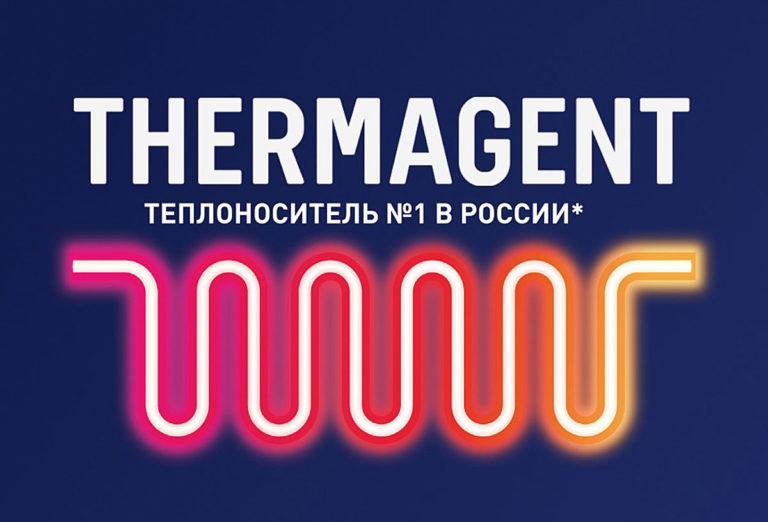
Conținutul articolului
Why it is necessary to use Thermagents in the heating system
If the heating circuit is filled with water, it is necessary to make sure that the properties of the liquid meet the requirements of the manufacturer of thermal equipment. High water hardness or high iron content in it can have a negative effect on the condition of the internal surfaces of the system. In order for this coolant to work reliably, it must be prepared in a certain way, for example, boiled and filtered to remove impurities.
Such a measure will help to reduce the risk of deposits inside the system. But it is impossible to influence the freezing temperature of water, and cooling the system to 0 ˚C and below can lead to deformation of pipes due to the increased volume of frozen liquid and failure of boiler equipment. If “Thermagent” based on propylene glycol is used as a coolant, such problems do not arise.
How propylene glycol-based “Thermagent” differs from water
Unlike water, “Thermagent” protects the heating system from defrosting, sludge formation, the appearance of corrosion centers. Depending on the concentration of glycol, the crystallization temperature of this coolant can range from -20 to -65 ˚C.
Differences between “Thermagents” based on propylene glycol and ethylene glycol
Propylene glycol-based “Thermagents” differ from ethylene glycol-based ones primarily in terms of environmental friendliness and safety. Propylene glycol is not dangerous for human health and the environment. Therefore, heat carriers based on it can be used without restrictions in food and pharmaceutical industries, in residential buildings and public facilities. In addition, propylene glycol is an authorized food additive (E1520), widely used in food products.
Ethylene glycol is characterized by high toxicity (third class of danger), and its contact with skin, mucous membranes or inside the body can lead to severe poisoning. Therefore, “Thermagent” based on ethylene glycol is recommended for use in closed heating systems of residential houses, industrial premises, administrative buildings where the circuit with Thermagent is sufficiently isolated and separated from household contact. Propylene glycol Thermagent is used without restrictions.
Physical characteristics of propylene glycol
Propylene glycol under normal conditions is a low-viscosity transparent liquid, easily soluble in water and alcohols. Due to its high hygroscopicity, the substance mixes evenly with different diluents, forming solutions with a uniform consistency and the same properties throughout the volume of the liquid. This feature of propylene glycol helps to create antifreeze for heating systems with specified characteristics: the substance is usually diluted with water to obtain the required values of density, fluidity, freezing and boiling point. The ability to mix with water has a positive impact on the market attractiveness of the product, which becomes more accessible to users.
Key advantages
Thermagents based on propylene glycol are gaining popularity in the domestic market due to a large number of advantages compared to coolants of other types. More and more often it is this composition is chosen by owners of private homes, cottages, dachas, other low-rise buildings to fill the systems of autonomous heating.
Non-toxicity. Ecological and sanitary safety of propylene glycol as a coolant makes it possible to use “Termagent” in two-circuit open heating systems, without fear that a small amount of the substance may end up in the DHW pipes. Presented by the product line ECO propylene glycol “Thermagent” does not contain toxic components and meets high environmental requirements. The product has a green color, making it difficult to confuse it with a toxic composition based on ethylene glycol.
Possibility of year-round use. An important advantage of “Thermagent” based on propylene glycol is that there is no need to drain it from the circuit at the end of the heating season. Remaining inside the system during the periods when the heating equipment is not used, the liquid does not cause corrosion and does not form deposits on internal surfaces. The system will remain operational for a long time, if at the time of its filling with coolant on the pipes and other elements there were no pockets of corrosion, internal scale and other defects.
Chemical inertness. “Thermagents” do not enter into chemical interaction with metal, plastic, rubber elements of the heating system. This feature of the coolant increases the working life of the most vulnerable parts and components of the autonomous heating circuit. Due to the use of “Thermagent” extends the service life of heat exchangers in boilers, heating radiators, circulation pumps, pipe fittings and other components. Due to chemical inertness of the coolant no cracks appear on rubber and silicone seals, which significantly reduces the likelihood of leaks at the joints.
Protective properties. Special additives present in the composition of “Thermagents” provide comprehensive protection of pipes, heating boilers, radiators, circulation pumps. Anticorrosive additives prevent the formation of rust on the inner surfaces of metal products. Having low corrosive activity “Thermagents” almost do not corrode metals, rubber and plastic. This makes it possible to save on equipment for heating systems, because there is no need to buy expensive components of the best grades of steel, special rubber connections, resistant to corroding plastic. Aluminum radiators are quite suitable for heating with Thermagent.
Contraindicated for use in systems with “Thermagent” only zinc pipes, because the interaction of this coolant with zinc forms a precipitate that impedes the circulation of the liquid. Such compositions as Thermagent -30/-20 ECO and Thermagent -40 Multi provide reliable protection against scale and other types of deposits.
Freeze resistance. In addition to low crystallization onset temperature (which, depending on the concentration, can be -20, -30 ˚C or -65 ˚C), “Thermagents” are characterized by volume stability during the transition from one aggregate state to another. Thus, while water increases in volume by 9% when freezing, Thermagents do not expand when freezing. This means that even if the coolant “Thermagent” in the system cools to a temperature below -30 ˚C, pipes and other equipment will not suffer. If water freezes in the circuit, it can lead to the destruction of pipes and radiators. Resistance to freezing makes “Termagent” extremely relevant for heating systems of objects built in the Far North.
Flexibility in application. Thermagent on the basis of propylene glycol is suitable for use in heating systems of different types, including those with double-circuit boilers. These units provide not only heating, but also hot water supply of premises. If for some reason there is a small amount of propylene glycol in the DHW system, it will not cause negative consequences for either users or equipment.
Versatility of propylene glycol coolant is also due to the admissibility of its use in systems with aluminum, copper, steel, cast iron, brass heat exchangers and components made of other materials. “Thermagent” does not interact with these materials and does not oxidize them. Therefore, it can be used in systems with any boilers and batteries, including – with bimetallic.
Service life in the heating system
Modern coolants – Thermagents are able to retain efficiency for a long time. Such compositions are characterized by stability of operational characteristics and successfully cope with their functions for 10 and more heating seasons. The working life of antifreeze depends on a number of factors.
The state of the system. It is important that “Thermagent” was filled into the system without pockets of corrosion, scale, leaks and other defects. Before filling the circuit, it is necessary to get rid of the remnants of old antifreeze. To do this, the system is washed with special compositions. This will increase the effectiveness of propylene glycol and eliminate the possibility of its mixing with foreign substances that can adversely affect the properties and resource of the new liquid.
Temperature regime. Regular heating of “Thermagent” to temperatures close to the maximum permissible, can affect the service life of the coolant. It is better to avoid these conditions. Long-term operation of the boiler at maximum output should also be avoided, unless it is absolutely necessary.
Addition of other antifreezes. If it is necessary to add another antifreeze to the circuit, it is necessary to make sure that the main and additional coolants are compatible. Mixing liquids that do not fit each other, will lead to the fact that “Thermagent” will lose its properties and will require a complete replacement of the liquid.
How the Thermagent is replaced in the system
Replacement of the coolant is carried out based on the regulations established by the manufacturer. If you need to change the fluid in the circuit, most likely, you will need the help of specialists. The standard algorithm of actions is as follows:
- From the heating circuit, drain the used liquid and distribute it into bottles or canisters for further shipment to the disposal point.
- Flush the system with clean water. This will prolong the service life of the new “Thermagent”. It is recommended to flush the internal surfaces of the circuit with special means.
- Before pouring new “Thermagent”, carefully check the condition of the entire system. It is important that the pipe fittings are in good working order, there is no damage to the batteries and boiler equipment.
- Bleed the air out of the system using special taps on the radiators.
- Fill the circuit with “Thermagent” through the expansion tank. In the process of filling the system with liquid, air will escape from the circuit. Close the valves after the air plugs have disappeared and the antifreeze starts to flow out.
- The system is switched on for a test run. The expansion tank should be filled to 30-50%. The fluid is heated to operating temperature, after which the air is vented again.
Whether it is necessary to add water to “Thermagent”
The manufacturer does not recommend diluting “Thermagent” with water, as it leads to deterioration of anti-corrosion properties of liquids. The exception is the concentrate Thermagent-65, which can be diluted with distilled or prepared water with hardness up to 6 units. “Thermagent” -30/-20 are available in a ready-made form, not requiring additional preparation or dilution before pouring into the heating circuit. Adding water to the coolant inevitably leads to a decrease in the protective properties and effectiveness of additives included in the composition of “Thermagent”. As a consequence, the crystallization temperature increases and the frost resistance of the liquid deteriorates.
In the factory composition water is present in the amounts calculated by the manufacturer in laboratory conditions. Any change in the ratio of water and glycol affects the efficiency and quality of antifreeze. On the packaging or in the product instructions, the manufacturer usually indicates whether the fluid can be diluted with water or other coolants.
In what cases early replacement is necessary
Thermagents do not lose their properties in the absence of external factors in the form of dilution, overheating, sharp temperature spikes, etc. That is, when used under ideal conditions, which is only theoretically possible. In practice, “Termagent” retains its stated properties for 5-10 years. Every year, after the end of the heating season, it is recommended to monitor the system, including checking the condition of the coolant. For this purpose, a small amount of liquid (40-50 mg) is drained from the lowest point of the circuit and the selected sample is compared with the original product, assessing its transparency, color concentration, checking for the absence of mechanical and chemical impurities.
If as a result of visual inspection no significant deviations are detected, the liquid continues to be used. Early replacement of “Thermagent” may be required after the repair of the system, for example, if new radiators and pipes are installed. It is also necessary to change the coolant prematurely after incorrect replacement of antifreeze, when the system was filled without preliminary flushing.
Disposal of used coolant
Despite the safety of propylene glycol coolants for humans and their nontoxicity, the disposal of these fluids requires compliance with certain rules. It is important to remember that these compositions have an alcohol base and when utilized are classified as hazard class III waste. It is forbidden to pour spent “Thermagents” into the ground and sewage system. It is also inadmissible to pour them into bottles and throw them into trash containers. Disposal of coolants based on propylene glycol are engaged in specialized organizations that have the technical capabilities to properly process drained from the heating system antifreeze. Different technologies can be used for the utilization of “Thermagents”, including:
- application of propylene glycol residues as fuel;
- regeneration with incineration of the obtained fragments;
- regeneration by distillation and disposal in solid waste.
Information about the nearest recycling points can be obtained from the antifreeze manufacturer or from the contractor who installed and filled the system.
How to choose the right “Thermagent” based on propylene glycol
The most important criterion for choosing “Thermagent” on a propylene glycol basis is the temperature of the beginning of crystallization of the liquid. This parameter is determined by the concentration of propylene glycol in the composition of the coolant. The more of the basic substance is contained in the antifreeze, the lower the temperature of the beginning of crystallization and solidification. In order not to make a mistake with the choice, it is necessary to take into account the climatic features of the region in which the use of “Thermagent” is supposed to be used. Thus, Thermagent ECO -30 ˚C contains 47% propylene glycol and withstands temperatures down to -30 °C. The composition looks more preferable for use in northern regions than, for example, Thermagent ECO -20 ˚C with a concentration of the main substance of 37%.
It is important to take into account that as the concentration of propylene glycol increases, the fluidity of the liquid decreases, i.e. Thermagent -30 ˚C ECO is more viscous than Thermagent ECO -20 ˚C. This property is taken into account when selecting a circulation pump. The less fluid the system is filled with, the more powerful the pump is required.
Thermagent is the No. 1 heat transfer fluid in Russia*.
(*according to MG “Tekart” research in 2022 by sales volume in Russia)
Thermagents for autonomous heating systems are created on propylene glycol or on ethylene glycol. The line of propylene glycol compositions is represented by three products: “Thermagent ECO -20 °C”, “Thermagent ECO -30 °C” and Thermagent Multi. Each of them has its own features and advantages.
Features of antifreeze “Thermagent ECO -20 °C”
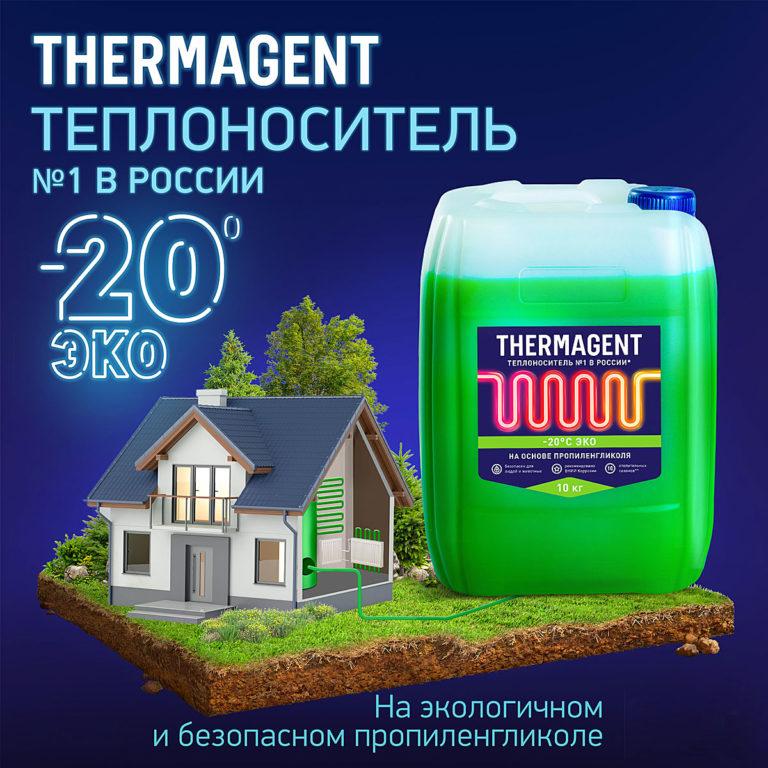
Made on the basis of propylene glycol of the highest grade Thermagent -20˚C is designed for use in heating systems of private homes, cottages and other facilities located in regions with a relatively warm or temperate climate. The latest Organic Acid Technology was used in the manufacture of the product. The antifreeze contains non-toxic organic corrosion inhibitors and special additives that improve the operational properties of the liquid.
Designed to operate in the temperature range from -20 to +105 ˚C “Termagent” can be used at facilities with high requirements to environmental safety. The coolant is well suited for heating systems of food, radio engineering, electronic industries. The composition can be used in refrigeration equipment. Thermagent -20 ˚C is available in different packaging – from 10 kg to 20 tons, which allows to use it in systems of different scale.
Thermagent ECO -30 °C coolant
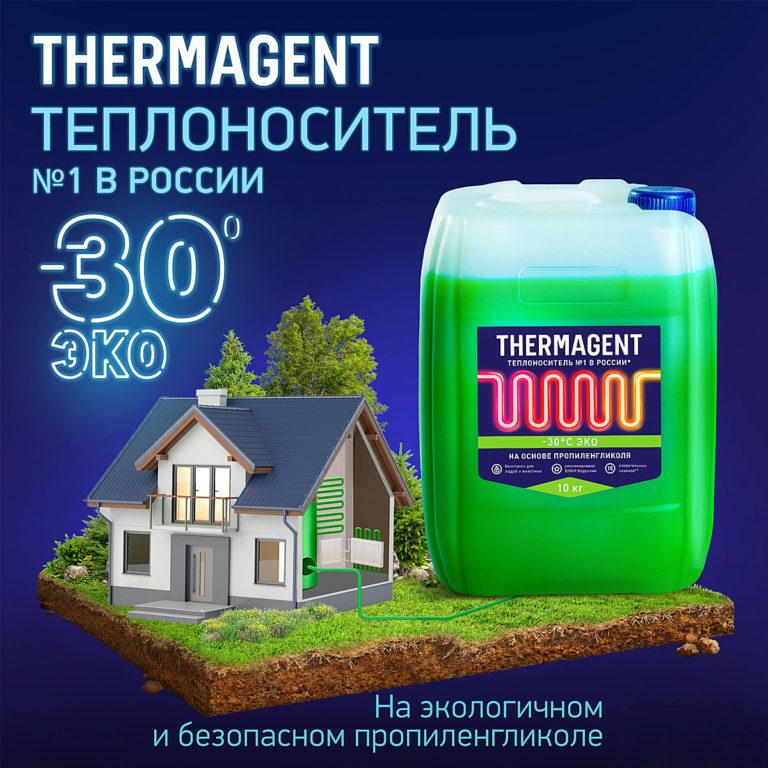
Thermagent -30 ˚C differs from the analog with freezing point -20 ˚C by increased concentration of propylene glycol: the content of the working substance is 47%, which is 10% more than in Thermagent -20 ˚C. As a consequence. Thermagent -30 ˚C has increased frost resistance: product crystallization begins at -30 ˚C, solidification occurs at -48 ˚C. In terms of resistance to subzero temperatures antifreeze is inferior only to ethylene glycol “Thermagent -65 °C”.
The characteristics of the liquid allow its use in heating systems of objects located in any climatic zones. Approved by leading manufacturers of equipment for heating systems Thermagent -30 ˚C is completely harmless for people, pets and indoor plants. A package of additives reliably protects equipment from scaling, foaming and corrosion. The average service life of the coolant is 10 heating seasons. The product is recommended for use in refrigeration equipment of food industry, as well as in radio engineering, electronic and other spheres.
Universal coolant Thermagent Multi
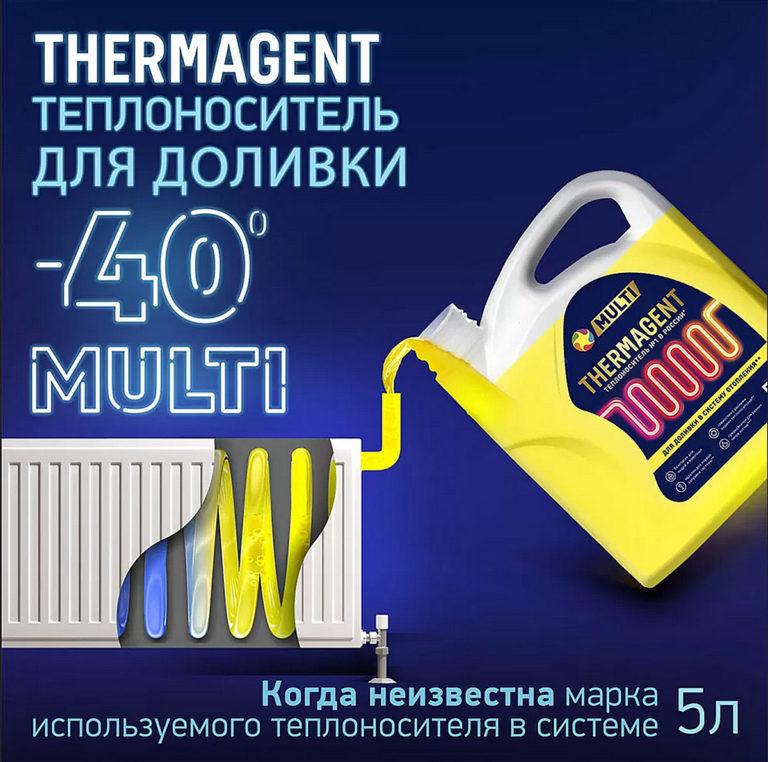
Thermagent Multi -40 ˚C is an antifreeze with special properties based on safe propylene glycol. The product is designed specifically for refilling into heating systems filled with water-glycol-based heat transfer fluids. The fluid can be refilled into circuits with both propylene glycol and ethylene glycol solutions. Created with the use of Organic Acid Technology “Thermagent Multi” has an extended service life and reliably protects ferrous and non-ferrous metals from corrosion. The composition is chemically neutral towards metal pipes, sanitary rubber and gasket materials, aluminum radiators. The presence of fluorescent dye simplifies the search for places of fluid leakage with the help of an ultraviolet lamp. This is extremely convenient, because refill antifreeze used primarily in the occurrence of leaks in the system.
Concluzie
“Thermagent” based on propylene glycol – an effective and safe coolant for autonomous heating systems of country houses, cottages, office buildings, industrial premises. Antifreeze perfectly copes with its functions, while extending the life of the equipment.

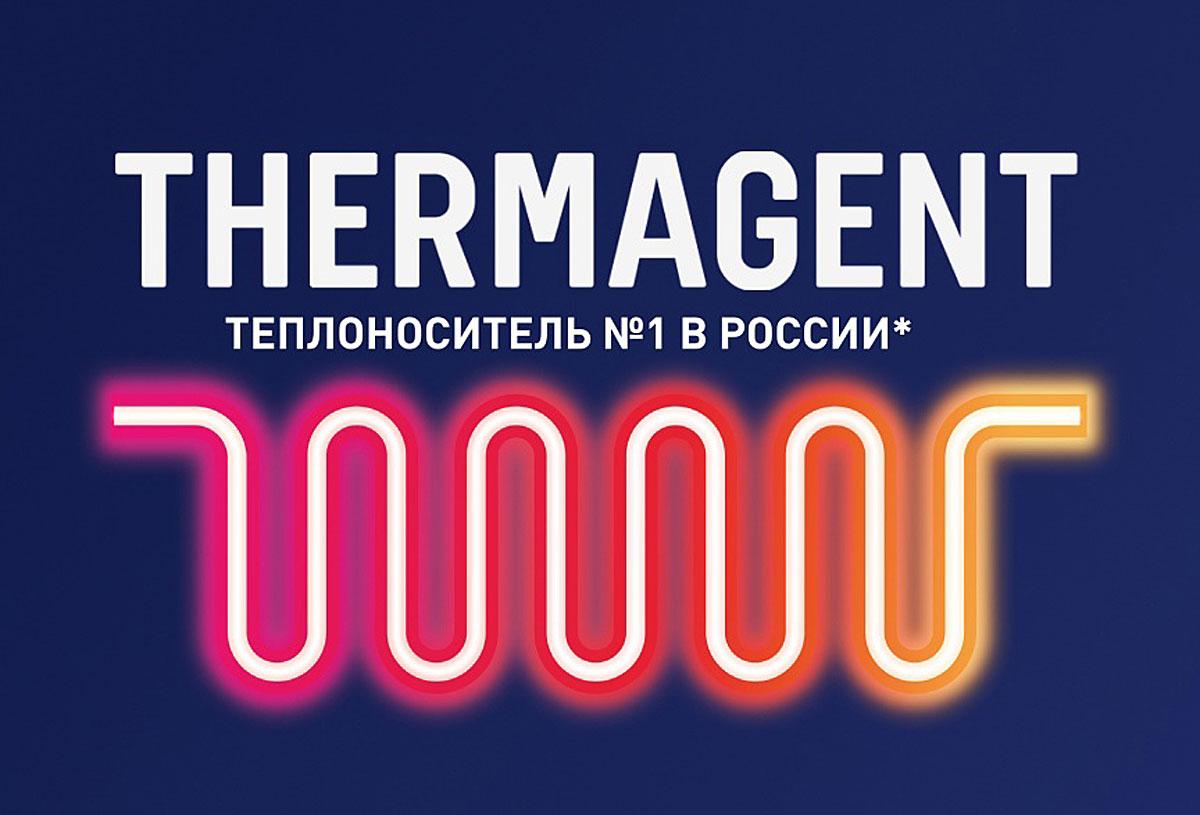
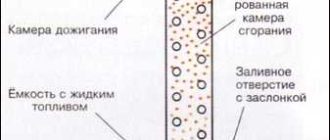
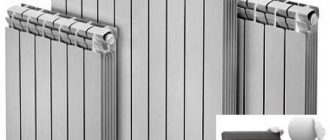
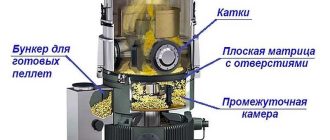
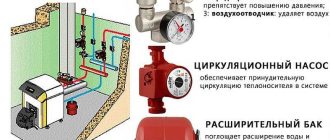
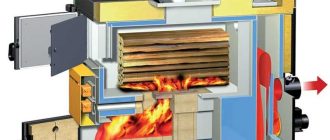

I’ve had hands-on experience with propylene glycol-based thermogents in my job. They’re super effective for temperature control in various industries, especially food and pharmaceuticals. The low toxicity makes them a safer choice compared to other options. Plus, they’re versatile and can adapt to different processes easily!
Totally agree! I once used propylene glycol in a food processing setup, and it worked wonders for keeping everything at the right temp. Super safe and adaptable, like you said. It really made a difference during the summer heat! It’s amazing how essential it is in so many industries.
Hey, I recently tried some thermogents with propylene glycol, and I was blown away! They really crank up the heat during workouts. Perfect for anyone looking to boost their performance or lose a few pounds. Seriously, give it a shot if you want to level up your game!